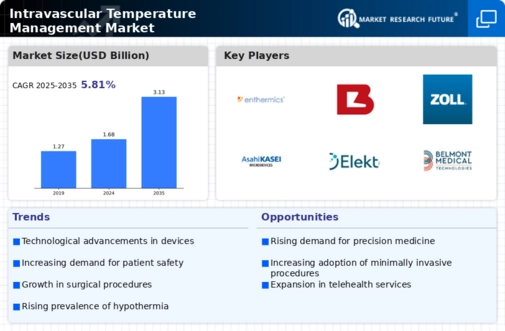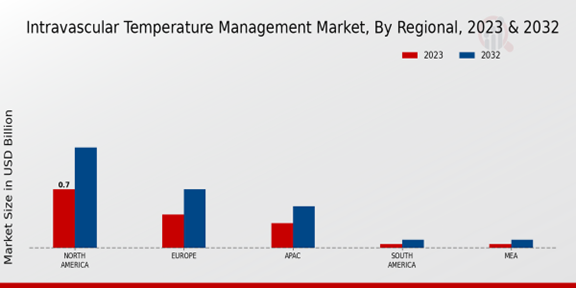Market Growth Projections
The Global Intravascular Temperature Management Market Industry is poised for substantial growth in the coming years. Projections indicate that the market will reach 1.68 USD Billion in 2024 and is expected to expand to 3.13 USD Billion by 2035. This growth trajectory suggests a compound annual growth rate (CAGR) of 5.83% from 2025 to 2035. Factors such as increasing surgical procedures, advancements in technology, and heightened awareness of patient safety are likely to drive this expansion. The market's evolution reflects the ongoing commitment to improving patient care and outcomes through effective temperature management solutions.
Rising Demand for Patient Temperature Management
The Global Intravascular Temperature Management Market Industry experiences a notable increase in demand for effective patient temperature management solutions. This trend is driven by the growing awareness of the importance of maintaining normothermia during surgical procedures and critical care. Hospitals and healthcare facilities are increasingly adopting intravascular temperature management systems to prevent hypothermia and hyperthermia, which can lead to complications. As a result, the market is projected to reach 1.68 USD Billion in 2024, reflecting a robust growth trajectory. The emphasis on patient safety and improved outcomes further propels the adoption of these technologies across various healthcare settings.
Growing Focus on Patient Safety and Quality of Care
The Global Intravascular Temperature Management Market Industry is increasingly shaped by the growing focus on patient safety and quality of care. Healthcare providers are prioritizing strategies that enhance patient outcomes, reduce complications, and improve overall satisfaction. Intravascular temperature management systems are recognized for their role in achieving these objectives, as they help maintain normothermia during critical procedures. The emphasis on quality improvement initiatives and patient-centered care is likely to drive the adoption of these technologies across healthcare facilities. As hospitals strive to meet patient safety standards, the demand for effective temperature management solutions is expected to rise, contributing to the market's expansion.
Increasing Surgical Procedures and Critical Care Admissions
The Global Intravascular Temperature Management Market Industry is significantly influenced by the rising number of surgical procedures and critical care admissions. As the global population ages and the prevalence of chronic diseases increases, more patients require surgical interventions that necessitate effective temperature management. Hospitals are increasingly recognizing the importance of maintaining optimal body temperature during surgeries to reduce complications and enhance recovery. This growing demand for temperature management solutions is expected to drive market growth, with a projected compound annual growth rate (CAGR) of 5.83% from 2025 to 2035. The expansion of surgical services and critical care units further underscores the need for these technologies.
Regulatory Support and Guidelines for Temperature Management
Regulatory bodies and healthcare organizations are increasingly emphasizing the importance of temperature management in clinical settings, thereby impacting the Global Intravascular Temperature Management Market Industry. Guidelines and recommendations from organizations such as the American Society of Anesthesiologists advocate for the use of temperature management devices to prevent perioperative hypothermia. This regulatory support not only raises awareness among healthcare providers but also encourages the adoption of intravascular temperature management systems. As compliance with these guidelines becomes essential for hospitals, the market is likely to witness sustained growth, driven by the need for adherence to best practices in patient care.
Technological Advancements in Temperature Management Devices
Technological innovations play a pivotal role in shaping the Global Intravascular Temperature Management Market Industry. The introduction of advanced intravascular temperature management devices, such as automated warming and cooling systems, enhances the precision and efficiency of temperature regulation. These devices often integrate with electronic health records, allowing for real-time monitoring and data analysis. As healthcare providers seek to improve patient outcomes and streamline operations, the demand for these sophisticated technologies is expected to rise. This trend is likely to contribute to the market's growth, with projections indicating an increase to 3.13 USD Billion by 2035, highlighting the potential for continued innovation.



















